Passion fuels forest protection in Palawan
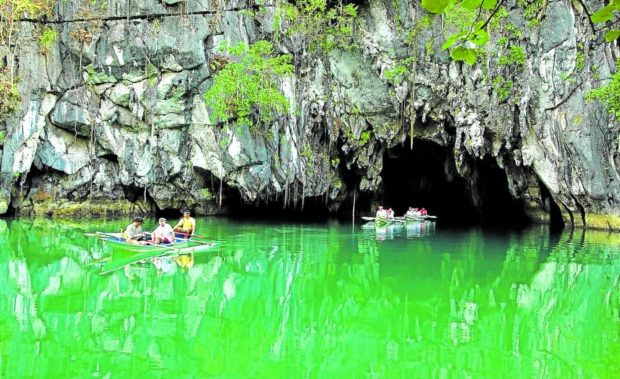
GLOBAL ATTRACTION | The Puerto Princesa Subterranean River National Park (PPSRNP) is globally known for its limestone karst landscape, featuring St. Paul’s Underground River Cave that stretches more than 24 kilometers. An 8.2-km underground river system winds through the cave before flowing into the West Philippine Sea. (PHOTO COURTESY OF PPSRNP PROTECTED AREA MANAGEMENT OFFICE)
PUERTO PRINCESA CITY, Palawan, Philippines — Evangeline Cabon, a member of the indigenous peoples (IP) group Batak, is a woman on a mission.
Walking for more than four hours each day, amid heavy rain or scorching heat, is nothing to the 46-year-old community organizer if only to reach Sitio Kayasan in the village of Cabayugan, an ancestral domain within the 22,202-hectare protected area inside the Puerto Princesa Subterranean River National Park (PPSRNP) in Puerto Princesa, one of the few remaining green cities in the country.
Cabon is coordinator of the PPSRNP Protected Area Management Office (Pamo), which helps local communities through livelihood opportunities that are environment-friendly. She also oversees the practice of community-based sustainable tourism, providing guidance in organic farming and other income-generating projects.
“Without the park, we are nothing. The forest gives life; it provides us medicine and food. If the forest is destroyed, we will lose our source of livelihood,” she said.
The national park, a major tourist attraction in Palawan, was ordered closed starting March 2020 when the pandemic was declared and as the city’s borders were shut to prevent the spread of COVID-19.
Article continues after this advertisementThe shutdown meant no income for the park as well as for communities that depended on tourism activities.
Article continues after this advertisementAs a result, about 81 percent of the 5,714 residents within the park experienced an unprecedented financial difficulty, which a Pamo study in 2021 considered as an immediate threat as people might resort to illegal activities so they could provide for their families.
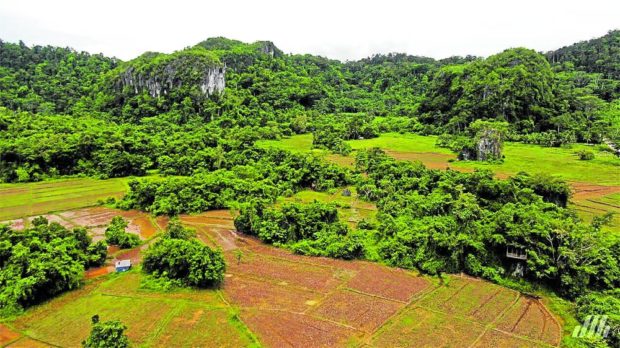
“Taraw ng Lumalayag” (Karst of the Voyager), tucked within the 22,202-hectare protected area (PA) and part of the Cabayugan ancestral domain, is considered as a sacred cave that housed the first Tagbanua settlers, Bayi Sinada and Apu Magsinambi. (Photo courtesy of GEOGGREY KLeoffrey Delahaye)
More than titles
It came as no surprise when park officials uncovered an alarming number of illegally cut trees during its post-Typhoon Odette (international name: Rai) inventory — another disaster that devastated the tourism-dependent communities in December 2021.
“This is very alarming. If we were able to confiscate 40 chainsaw units operating in Cabayugan alone, a protected area, how much more in other villages? The entire forest in Puerto Princesa will be gone,” said park superintendent Elizabeth Maclang.
The PPSRNP, listed as a Unesco World Heritage Site in 1999, and voted as one of the New7Wonders of Nature in 2012, covers three ancestral domains in the villages of Cabayugan, Tagabinet and Marufinas. These areas are home to 90 percent of the Batak, Tagbanua and Palaw’an communities, the three remaining ethnic groups in Puerto Princesa City.
The park is also a proclaimed geological monument, a key biodiversity area, and important bird area, and a wetland of international importance under the Ramsar Convention, with more than 800 plant species and 165 species of birds, some of which are endangered, rare or endemic.
But for Cabon, a handicraft weaver before she became a community organizer in 2016, the PPSRNP is much more than the precious titles it holds as it represents the culture of its people and serves as a lifeline of a thriving community.
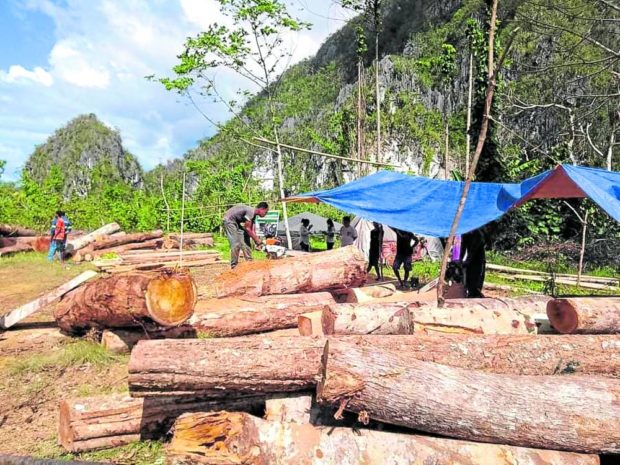
ENVIRONMENTAL CRIME | The management of the PPSRNP has reminded communities in Puerto Princesa City about protecting local forests after illegally cut trees are discovered during its post-Typhoon “Odette” (Rai) inventory last February. —PHOTO COURTESY OF ELIZABETH MACLANG/PPSRNP
The primary sources of income for IP communities in the park are farming, fishing, forestry, and tourism-related income generating activities.
For centuries, the park has been providing for its people from the abundance of its forest.
‘Debt of gratitude’
One popular source of revenue for the IPs is by going up to the mountain for several days to gather almaciga resin, or “bagtik,”—an ingredient in varnish and paint—and selling it outside the village. A sack of almaciga is sold for about P2,000, which is enough to sustain a family for a week.
Owing “debt of gratitude” to the forest, the IP elders called for suspension of resin extraction last year due to overextraction and depletion of supply.
More than 1,138 sacks of almaciga resin had not been released to the market because the IPs collected these without renewing their permits and gathering beyond their quota, based on a survey conducted by PPSRNP officials since April 2021.
The park management team also found almaciga trees in bad shape, having been carved too many times in order to extract resin.
Speaking for the elders, Vilma Aguilar, the city’s IP mandatory representative, said that as part of the IPs’ commitment to protect the natural biodiversity of the area, gatherers were allowed to collect only five sacks of resin every season.
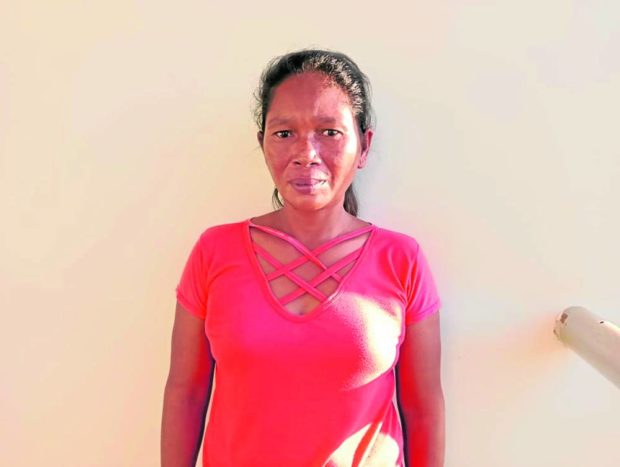
ORGANIZER | Evangeline Cabon, 46, a Batak, is a former handicraft maker who has turned to community organizing to assist villagers in Puerto Princesa’s protected area in livelihood projects. (ROMAR MIRANDA)
Aguilar said the elders warned that if the harvesting of resin would continue unhampered, it would spell the end of their livelihood.
“We have to remember that we created these policies. We [made a promise] so we also have to make sure we follow [these], because this is not just for us but also for the future generations. We do not have luxuries, like expensive jewelry or makeup, we only need the essentials. We should only get what we need,” Aguilar said.
Other IP families gather rattan and honey from the forests. Village women also produce woven items, flower pots, beaded necklaces, other trinkets and some indigenous household items like baskets.
“If there are no customers, we have no income. Now, at least we get training and education on how to sustainably support our needs while also taking care of nature,” Cabon said.
Javier Ello, 55, a Tagbanua farmer who has been working as a park ranger for six years, considers his task as “critical” as members of his group are considered the first responders to illegal activities.
The park, for decades, has been hounded with illegal activities such as “kaingin” (slash-and-burn farming), poaching, logging, land clearing and development, and small-scale quarrying.
Within its bounds, 3,901 ha of the protected area was declared as a World Heritage Zone and 704 ha as a no-fishing zone. Human activities are prohibited in these zones to protect and preserve the key biodiversity area.
“Our job is [replete with danger]. We are the first in line [in stopping] illegal human activities,” Ello said.
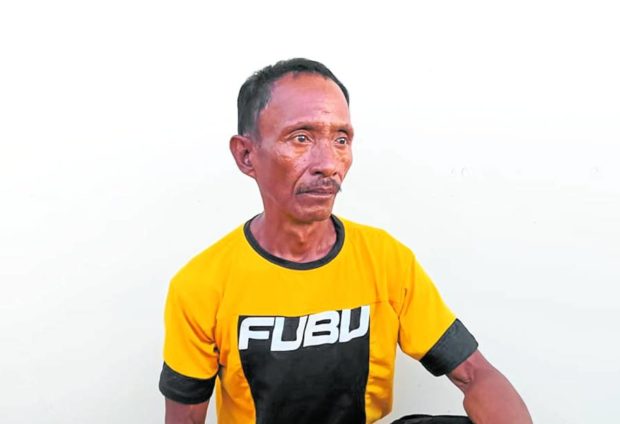
GUARDIAN | Javier Ello, 55, a Tagbanua, is both a farmer and a park ranger who has been guarding Puerto Princesa’s forests from illegal activities in the past six years. (ROMAR MIRANDA)
Hope for sustainability
For park superintendent Maclang, who has been serving as PPSRNP’s chief program director for over nine years, the task of protecting Puerto Princesa’s environmental treasure goes beyond their 8 a.m. to 5 p.m. work shift.
“Our environmental advocacy journey is fueled by passion. It’s not just an office work that ends after an eight-hour shift. After solving one problem, another one [crops] up and these cannot be simply addressed by your desire to [receive your] salary. It is commitment,” Maclang said.
But the IP communities and park administrators have found partners to sustain efforts in protecting the PPSRNP.
Since 2014, PPSRNP Pamo and Pilipinas Shell Foundation Inc. (PSFI) have partnered in promoting backyard gardening among the communities to ensure local food security. The initiative has transformed into an alternative livelihood to this backyard gardeners as their produce are now being bought by PSFI through their “Ani para sa Bayani” program.
While most community members rely on their backyard gardens to survive, the park’s own Agro-Forestry Nursery has given away vegetables for household consumption and to sustain food production.
Yamang Bukid Farm, a private organization that helps farmers in Palawan, has also donated seedlings for the community-based sustainable tourism sites in the protected area.
“Other than skills and passion, you need to have courage even though you’re facing death threats. There were many illegal activities that we had to dismantle. Slowly, we gained the trust of locals [and this] eventually helped us,” Maclang said.
In years to come, Maclang and the 117 park employees are hoping that local families will have sustainable means of livelihood so they can preserve the local environment.
“We hope to see a future where there is no more poaching … We want at least 90 percent of locals to have a sense of ownership in the community — [a situation where] we develop and protect our natural resources while still [earning],” Maclang said.
(This story is produced with support from Internews’ Earth Journalism Network.)
RELATED STORIES
P 1.2-B worth of giant clam shells seized in Palawan; 4 nabbed